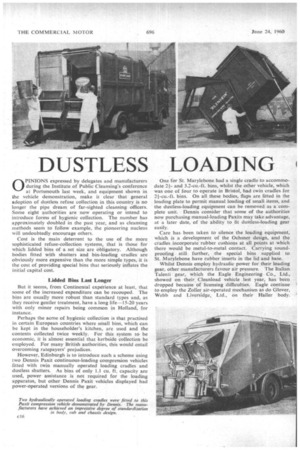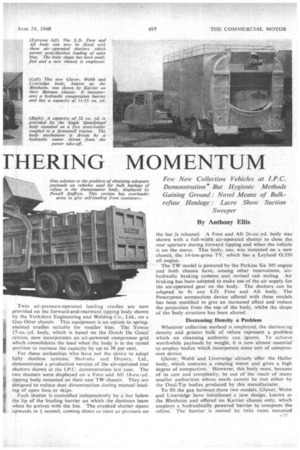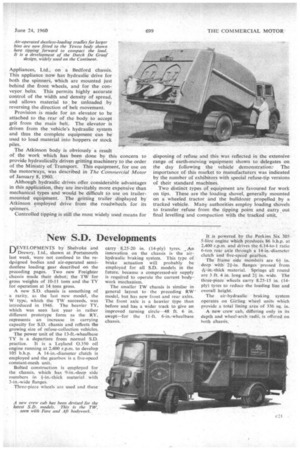DUSTLESS LOADING THERING MOMENTUM
Page 54

Page 55

Page 56

Page 59

If you've noticed an error in this article please click here to report it so we can fix it.
By Anthony Ellis
OPINIONS expressed by delegates and manufacturers during the Institute of Public Cleansing's conference at Portsmouth last week, and equipment shown in the vehicle demonstration, make it clear that general adoption of dustless refuse collection in this country is no longer the pipe dream of far-sighted cleansing officers. Some eight authorities are now operating or intend to introduce forms of hygienic collection. The number has approximately doubled in the past year, and as cleansing methods seem to follow example, the pioneering nucleus will undoubtedly encourage others.
Cost is the main deterrent to the use of the more sophisticated refuse-collection systems, that is those for which lidded bins of a set size are obligatory. Although bodies fitted with shutters and bin-loading cradles are obviously more expensive than the more simple types, it is the cost of providing special bins that seriously inflates the initial capital cost.
Lidded Bins Last Longer But it seems, from Continental experience at least, that• some of the increased expenditure can be recouped. The bins are usually more robust than standard types and, as they receive gender treatment, have a long life-15-20 years with only minor repairs being common in Holland, for instance.
Perhaps the acme of hygienic collection is that practised in certain European countries where small bins, which can be kept in the householder's kitchen, are used and the contents Collected twice weekly. For this system to be economic, it is almost essential that kerbside collection be employed. For many British authorities, this would entail overcoming ratepayers' prejudices.
However, Edinburgh is to introduce such a scheme using two Dennis Paxit continuous-loading compression vehicles fitted with twin manually operated loading cradles and dustless shutters. As bins of only 1.1 cu. ft. capacity are used, power assistance is not required for the loading apparatus, but other Dennis Paxit vehicles displayed had power-operated versions of the gear. One for St. Marylebone had a single cradle to accommodate 21-and 3.2-cu.-ft. bins, whilst the other vehicle, which was one of four to operate in Bristol, had twin cradles for 2+-cu.-ft. bins. On all these bodies, flaps are fitted in the loading plate to permit manual loading of small items, and the dustless-loading equipment can be removed as a:complete unit, Dennis consider that some of the authorities now purchasing manual-loading Paxits may take advantage, at a later date, of the ability to fit dustless-loading gear easily.
Care hasbeen taken to silence the loading equipment, which is a development of the Ochsner design, and the cradles incorporate rubber cushions at all points at which there would be metal-to-metal. contact. Carrying soundproofing still further, the special bins supplied to St. Marylebone have rubber inserts in the lid and base.
Whilst Dennis employ hydraulic power for their loading gear, other manufacturers favour air pressure. The Italian Talenti gear, which the Eagle Engineering Co., Ltd., showed on their Cleanload vehicle last year, has been dropped because of licensing "difficulties. Eagle continue to employ the Zoller air-operated mechanism as do Glover, Webb and Liversidge, Ltd., on their Haller body.
Twin air-pressure-operated loading cradles are now provided on the fOrward-and-rearward tipping body shown by the Yorkshire Engineering and Welding Co., Ltd., on a Guy Otter chassis. This equipment is an option to springassisted cradles suitable for smaller bins. The Yewco 17-cu.-yd. body, which is based on the Dutch De Graaf system, now incorporates an air-powered compressor grid which consolidates the load when the body is in the raised position to increase the capacity by up to 30 per cent.
For those authorities who have not the desire to adopt fully dustless systems, Shet),oke and Drewry, Ltd., demonstrated a -production version of the air-operated rear shutters shown at the I.P.C. demonstration last year. The two shutters were displayed on a Fore and Aft 18-cu.-yd. tipping body mounted on their new TW chassis. They are designed to reduce dust dissemination during manual loading of open bins or skips.
Each shutter is controlled independently by a bar below the lip of the loading barrier on which the dustman leans when he arrives with the bin. The cranked shutter opens upwards in -3-r second, coming down as soon as pressure on
the bar is released. A Fore and Aft 26-cu.-yd. body was shown with a full-width air-operated shutter to close the rear aperture during forward tipping and when the vehicle is on the move. This body, too, was mounted on a new chassis, the 14-ton-gross TY, which has a Leyland 0.350 oil engine.
The TW model is powered by the Perkins Six 305 engine and both chassis have, among other innovations, air-hydraulic braking systems and revised cab styling. Air braking has been adopted to make use of the air supply for the air-operated gear on the body. The shutters can be adapted to fit any S.D. Fore and Aft body. The Powerpress compaction device offered with these models has been modified to give an increased effect and reduce the projection from the top of the body, whilst the shape of the body structure has been altered.
Decreasing Density a Problem
Whatever collection method is employed, the decreas'ng density and greater bulk of refuse represent a problem which no cleansing authority can ignore. To achieve worthwhile payloads by weight, it is now almost essential to employ bodies which incorporate some sort of compression device.
Glover, Webb and Liversidge already offer the Haller body, which contains a rotating worm and gives a high degree of compaction. However, this body must, because of its cost and complexity, be out of the reach of many smaller authorities whose needs cannot be met either by the Dual-Tip bodies produced by this manufacturer.
To fill the gap between these two models, Glover, Webb and Liversidge have introduced a new design, known as the Blenheim and offered on Karrier chassis only, which employs a hydraulically powered barrier to compress the refuse. The barrier is moved by twin rams mounted beneath the roof at the rear and sweeps forward and upward to give the packing action. When the body tips
for discharge; the rear section swings upwards to give an unobstructed aperture. Blenheim bodies of 11-15-cu.-yd. and 22-30-cu.-yd. capacity were shown on Karrier Bantam and Karrier 6-ton chassis respectively.
Eagle have speeded up the action of the compression plate fitted in their Compressmore Oldies, of which several
examples were exhibited. To reduce wear on the body floor in the area of the plate, panelling is now in Cor-Ten. steel. The Eagle Speedyload rotating compression body can now be mounted on a semi-trailer, and was shown by Scammell Lorries, Ltd., in this form coupled to a Scarab 6-ton tractor.
The body is driven by a hydraulic motor powered from a pump on the prime mover. The 27-ft.-long outfit, which has a capacity of 32 cu. yd., can be turned in a 30-ft.-wide Street in one movement, and is therefore of obvious interest to urban authorities.
Detail improvements to their Pendulum refuse bodies by John Gibson and Son. Ltd., have resulted in a faster compression action. The hydraulic ram for the compression device is now mounted on the chassis, whereas formerly it was attached to the body.
Whilst the manufacturers of collection bodies are occupied in getting more refuse into the same space, a similar problem con fronts those concerned with carrying collected refuse from transfer stations to distant disposal sites. Where such movement is carried out by road, it has become usual to use eight-wheelers with 40-44-cu.-yd. tipping or movingfloor bodies. When these are loaded with uncompressed refuse, the total payload rarely exceeds 6 tons or about half the actual carrying capacity of the chassis.
Two methods of obtaining satisfactory payloads for bulk vehicles were on view at Portsmouth. The Dumpmaster body, shown by the Powell Duffryn Engineering Co., Ltd., on a Foden eight-wheeler, incorporates a five-stage hydraulic ram and full-width barrier which compresses refuse, loaded through an aperture in the front of the roof, c18 towards the substantial rear doors. With certain types of refuse, compression up to 3 to 1 can be achieved to give a total capacity of well over 60 cu. yd. Salford are to employ three of these vehicles in conjunction with a new transfer station shortly to be completed.
A Foden six-wheeler was demonstrated with a similar body •but with front overloader arms to allow self-loading from large containers. This vehicle could conceivably be used to service refuse containers in flat and office blocks, but would seem to lack manieuvrability for urban working. The Powell Duffryn Dinosaur is a demountable body system whereby large container's, which could be static storage points for refuse; can be picked up and dropped without external aid. It was mounted on an Atkinson chassis.
Whereas the Powell Duffryn refuse-compression equipment is Contained entirely on the vehicle, Walkers and County Cars, Ltd., have developed a complete system to ensure full loads for bulk vehicles. It entails a static installation, and was shown in model form at Portsmouth. The eight-wheeled • vehicles to be used are equipped with circular-section bodies which are charged with the output from a static:compression-plant in the form of a cartridge of compressed refuse. As the • Plant. carries out all compression, the vehicle body can be of light construction to permit the maximum payload. It incorporates a single-acting hydraulic ram and barrier to discharge the load without tipping.
As though in answer to Mr. S. J. Burn's plea in The Commercial Motor-on June 10, Lacre Lorries, Ltd., introduced a new suction street sweepercollector at Portsmouth. This vehicle, built under licence in this country, is based on a Bedford 6-ton chassis ' and provides a sweeping width of 6 ft. or. 1 ft. 7 in., depending upon
.t h e combination o f brushes used. It can be arranged to give either offside or near-side sweeping.
The 9+-in.-diameter suction orifice is just ahead of a narrow clockwise-rotating transverse brush which loosens dirt and feeds it to the nozzle. Both the nozzle and this brush are carried on parallel trailing arms to enable them to be outrigged from the vehicle. A wide transverse brush ahead of the suction duct directs dirt towards the gutter. The hopper has a capacity of 4 cu yd. and discharges by tipping, whilst a 200-gal. tank for the water sprays is provided. All the sweeping gear is powered by the main engine, and the vehicle will sweep at up to 6 m.p.h.
Among the other new equipment shown was a 7-ton gritter body demonstrated by Atkinsons Agricultural Appliances, Ltd., on a Bedford chassis. This appliance now has hydraulic drive for both the spinners, which are mounted just behind the front wheels, and for the conveyor belts. This permits highly accurate control of the width and density of spread, and allows material to be unloaded by reversing the direction of belt movement.
Provision is made for an elevator to be attached to the rear of the body to accept grit from the main belt. The elevator is driven from the vehicle's hydraulic system and thus the complete equipment can be used to load material into hoppers or stock
The Atkinson body is obviously a result of the work which has been done by this concern to provide hydraulically driven gritting machinery to the order of the Ministry of Transport. This equipment, for use on the motorways, was described in The Commercial Motor of January 8, 1960.
Although hydraulic drives offer considerable advantages in this application, they are inevitably more expensive than mechanical types and would be difficult to use on trailermounted equipment. The gritting trailer displayed by Atkinson employed drive from the roadwheels for its spinners.
Controlled tipping is still the most widely used means for disposing of refuse and this was reflected in the extensive range of earth-moving equipment shown to delegates on the day following the vehicle demonstration: The importance of this market to manufacturers was indicated by the number of exhibitors with special refuse-tip versions of their standard machines.
Two distinct types of equipment are favoured for work on tips. These are the loading shovel, generally mounted on a wheeled tractor and the bulldozer propelled by a tracked vehicle. Many authorities employ loading shovels to transfer refuse from the tipping point and carry out final levelling and compaction with the tracked unit.












































































































